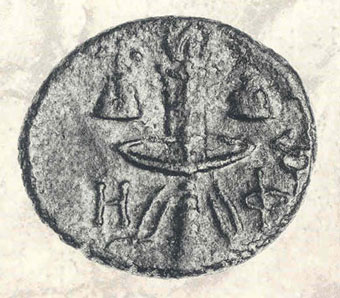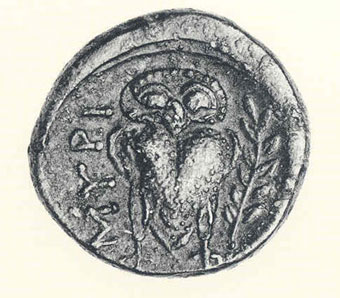Greek Islands Ancient Coins
"Limnos Coin-Bronze Coin"
Limnos in the north Aegean was colonised by Minyans from Thessaly and enjoyed days of great wealth and prosperity. An echo of this fact is to be sought in the legends surrounding the marriages of king Thoas to Myrina, daughter of the king of Iolkos, of Jason to Hypsipyle, queen of Limnos, and of the Argonauts to the women of Limnos. We learn from Herodotus that at the beginning of the first millennium, Pelasgians from Hymettos, pursued by the Archaeans, established themselves on the island, and quickly emerged as a major naval power. They are credited with the first use of the ram on ships. Despite the fierce resistance of the inhabitants, Limnos fell to the Persians in 512/11 BC. After the death of the tyrant Lykaretos, the Athenians once more laid claim to rule over the island. After the failure of the Ionian revolt Limnos, like the other Aegean islands, succumbed once again to the Persian yoke and was obliged to contribute ships to the Persian campaign against Greece. After the Persian Wars, the island became a member of the Delian Confederacy. Athenian cleruchs were settled on the island in 440-439 BC, and it was thereafter regarded as Athenian territory.
Unlike the other Aegean islands, Limnos issued no coins in the Archaic period. The mints of the two most important cities on the island, Hephaisteia and Myrina, struck bronze coins from the 3rd c. BC. The frequent discovery of these over the entire island, combined with the variety of their iconographic types, points to a relatively large output, though its significance was never more than local.
One characteristic type of the coins of Myrina consists of the head of Athena wearing a Corinthian helmet and the owl, which is clear evidence of the Athenian influence on the island.
The coinage of Hephaisteia is marked by a wide variety of types, influenced by the cults of local gods such as Hephaistos and the Kabeiroi. The lit torches are probably an illusion to cult acts in honour of Hephaistos. The representation of a ram is not only associated with the local cult of Hermes as protector of shepherds, but also points to the fact that the inhabitants were occupied in stock-raising. The cult of Dionysos and the large output of Limnian wine on the island are also confirmed by the depiction of a grape.







